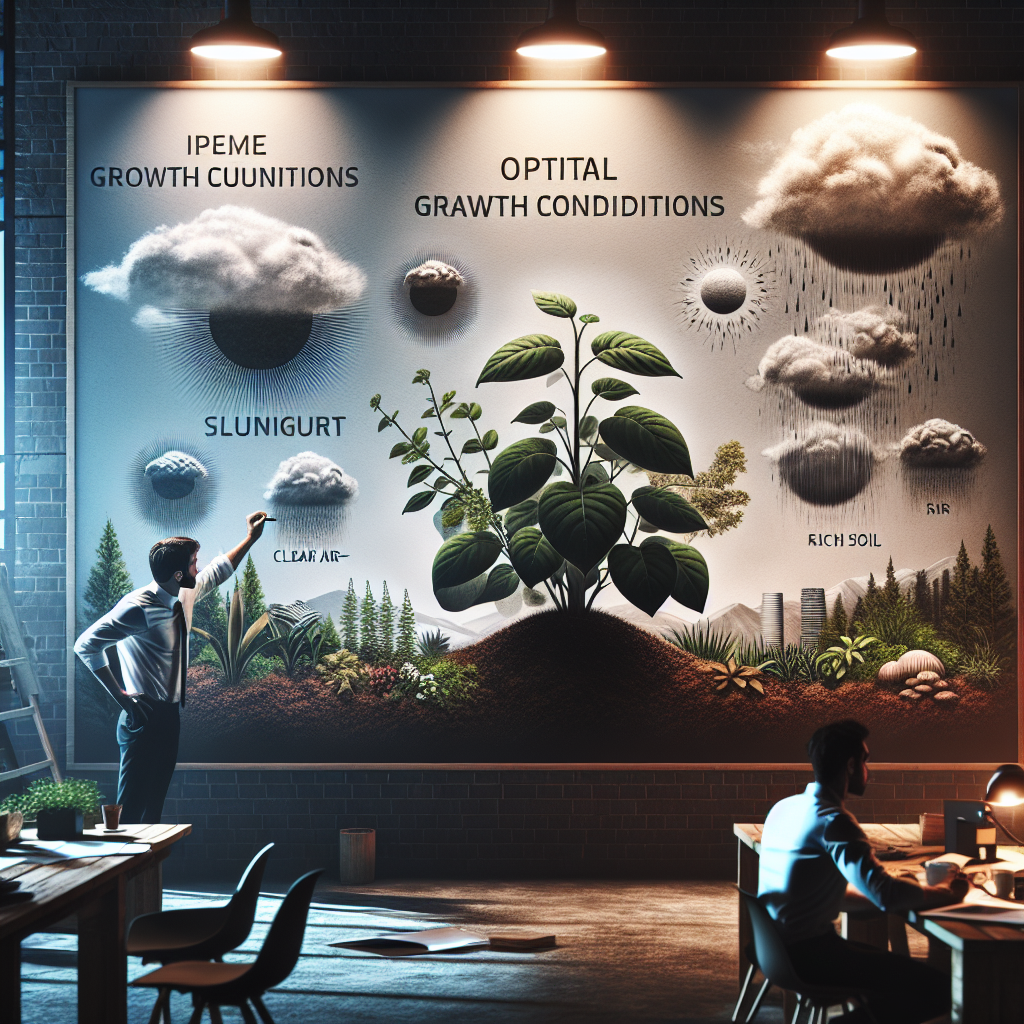Ideal Temperature And Humidity For Growth

Ideal Temperature And Humidity For Growth. Are you curious about the ideal conditions for optimal growth of plants? Well, look no further! In this article, we will explore the fascinating world of temperature and humidity and their impact on plant growth. Understanding the ideal climate for plants can help you create the perfect environment for your green companions to thrive. So, let’s embark on this journey together and discover the secrets behind the ideal temperature and humidity for growth.
Ideal Temperature
Definition of ideal temperature
The ideal temperature refers to the specific range of temperatures that provide optimal conditions for the growth and development of plants. It is the temperature at which plants can thrive and achieve their maximum potential. This range of temperatures allows for efficient photosynthesis, nutrient absorption, and overall physiological processes necessary for healthy plant growth.
Factors affecting ideal temperature for growth
Several factors influence the ideal temperature for plant growth. These include the plant species, growth stage, and environmental conditions. Different plant species have varying temperature requirements, and it is essential to consider these specific needs when providing optimal growing conditions. Additionally, the growth stage of the plant also plays a role, as different stages may have different temperature preferences. Lastly, environmental conditions such as light intensity, humidity, and air movement can also affect the ideal temperature for growth.
Temperature ranges for different growth stages
Each growth stage of a plant has different temperature requirements. During the germination and seedling stage, temperatures between 60°F (15°C) to 75°F (24°C) are generally considered ideal. As the plant enters the vegetative stage, temperatures ranging from 70°F (21°C) to 85°F (29°C) are preferable. During the flowering and fruiting stage, temperatures between 65°F (18°C) to 80°F (27°C) are optimal. These temperature ranges support the plants’ physiological processes, ensuring efficient growth and development.
Optimal temperature for photosynthesis
Photosynthesis, the process by which plants convert light energy into chemical energy, is vital for their growth. The optimal temperature for photosynthesis varies among plant species but generally falls within the range of 68°F (20°C) to 77°F (25°C). At this temperature range, the efficiency of photosynthesis is maximized, leading to greater production of carbohydrates and biomass. However, it is important to note that some plant species may have different temperature requirements for optimal photosynthesis.
Effect of extreme temperatures on growth
Extreme temperatures, whether excessively high or low, can have detrimental effects on plant growth. When exposed to extremely high temperatures above their optimal range, plants can experience heat stress. This can lead to wilting, leaf damage, reduced growth, and even death in severe cases. On the other hand, extremely low temperatures can cause frost damage, freezing of plant tissues, and hinder physiological processes. It is crucial to protect plants from extreme temperatures to ensure optimal growth and prevent damage.
Ideal Humidity
Definition of ideal humidity
Ideal humidity refers to the ideal level of moisture or water vapor present in the air surrounding the plants. It is an essential environmental factor that affects plant growth and development. The ideal humidity levels allow plants to maintain appropriate water balance, nutrient uptake, and efficient transpiration processes necessary for their overall health and vitality.
Importance of humidity for growth
Humidity plays a crucial role in plant growth. It directly affects the plant’s ability to regulate water loss through transpiration. The right humidity levels ensure that plants can efficiently absorb water through their roots and release it through tiny pores called stomata on their leaves. This process allows for the uptake of vital nutrients and minerals and helps maintain structural integrity. Proper humidity levels also prevent excessive water loss, which can lead to wilting and dehydration.
Humidity preference for different plant types
Different plant types have varying humidity preferences. Tropical plants, for example, thrive in high humidity environments, typically ranging from 50% to 70%. On the other hand, desert plants are adapted to low humidity conditions and can withstand levels as low as 20%. Understanding the specific humidity requirements for different plant types is crucial in providing optimal growing conditions and ensuring their well-being.
Effect of low humidity on growth
Low humidity levels can adversely impact plant growth. When the air around the plants becomes too dry, the rate of water loss through transpiration increases. This can lead to water stress and reduced nutrient absorption, resulting in stunted growth and decreased yield. Additionally, low humidity can cause the drying out of leaf tissues, causing damage and increasing the risk of pest infestations and diseases.
Effect of high humidity on growth
While high humidity is preferred by some plant species, excessively high levels of humidity can also negatively affect plant growth. In humid conditions, transpiration is reduced, leading to a decrease in the uptake of vital nutrients from the soil. High humidity also creates a favorable environment for the development of fungal diseases, such as powdery mildew and botrytis, which can significantly impact plant health. It is essential to strike a balance and provide optimal humidity levels to promote healthy growth.

Temperature and Humidity Interactions
Impact of temperature on humidity levels
Temperature and humidity are closely intertwined environmental factors that influence each other. As temperature increases, the air can hold more moisture, resulting in a decrease in relative humidity. Conversely, as temperature decreases, the air’s capacity to hold moisture decreases, leading to an increase in relative humidity. Understanding this relationship is crucial in maintaining appropriate humidity levels for optimal plant growth.
Effect of humidity on temperature perception
Humidity levels can also affect temperature perception. High humidity makes the air feel warmer than it actually is, while low humidity can make the air feel cooler. This perception can impact plant growth as it affects the plants’ metabolic processes, including the opening and closing of stomata. Balancing humidity levels with temperature is important to maintain optimal growing conditions and ensure the plants’ well-being.
Combined effects of temperature and humidity on growth
The combined effects of temperature and humidity significantly impact plant growth. When temperature and humidity are within the optimal ranges for a specific plant species, the plants can efficiently perform photosynthesis, transpiration, and other essential physiological processes. However, if there is a significant deviation from the ideal temperature and humidity, plants may experience stress, reduced growth, and decreased overall health. It is crucial to monitor and adjust these environmental factors to provide the best conditions for desirable plant growth.
Adapting temperature and humidity for optimal growth
Depending on the plant species and growth stage, it may be necessary to adapt temperature and humidity levels to achieve optimal growth. This can be done through various methods such as adjusting the greenhouse or indoor environment, implementing misting or fogging systems, or using fans to increase air movement. Monitoring and understanding the specific needs of the plants are key in creating an environment that promotes their growth and well-being.
Temperature and Humidity Measurement
Methods for measuring temperature
There are several methods available for measuring temperature accurately. One commonly used method is using a thermometer, which can provide a precise reading of the ambient temperature. Digital thermometers are widely available and offer quick and accurate measurements. In more sophisticated systems, temperature sensors can be integrated into environmental monitoring systems to provide real-time data and facilitate automated control processes.
Tools for measuring humidity
Humidity can be measured using a hygrometer or a psychrometer. A hygrometer measures the relative humidity in the air, while a psychrometer measures the humidity by comparing the readings of two thermometers, one of which is covered with a wet wick. Both these tools provide valuable insights into the moisture content in the air surrounding the plants. Advances in technology have led to the development of digital hygrometers and integrated environmental monitoring systems that offer more precise and convenient humidity measurements.
Importance of accurate measurement
Accurate measurement of temperature and humidity is vital in providing the best conditions for plant growth. It allows growers to monitor and adjust environmental factors to optimize plant health and productivity. Accurate measurements provide valuable data that can help identify potential issues, such as high temperatures or low humidity, allowing for prompt corrective actions. Precise measurements also aid in troubleshooting problems and ensuring the consistency and quality of plant growth.
Monitoring temperature and humidity levels
Regular monitoring of temperature and humidity levels is essential to ensure optimal conditions. This can be done using data loggers, which record temperature and humidity data over time. These loggers can be placed strategically in different areas to capture variations, giving growers a comprehensive understanding of the growing environment. Additionally, integrated environmental monitoring systems can provide real-time data, allowing for immediate adjustments and proactive management of temperature and humidity levels.

Controlling Temperature and Humidity
Natural methods for controlling temperature and humidity
There are various natural methods available for controlling temperature and humidity in the growing environment. Increasing airflow through the use of vents, fans, or natural ventilation can help regulate temperature and humidity levels. Other methods include shading the plants from direct sunlight, incorporating thermal mass to absorb and release heat, and using misting or fogging systems to increase humidity. These natural methods can be effective in maintaining optimal growing conditions while minimizing energy consumption.
Artificial methods for controlling temperature and humidity
In situations where natural methods are insufficient or not feasible, artificial methods can be employed to control temperature and humidity. Heating systems, such as heaters or radiant heating, can be used to elevate temperature during colder periods. Conversely, cooling systems like air conditioners or evaporative coolers can be utilized to lower temperatures in hot climates. Humidifiers and dehumidifiers can be employed to increase or decrease humidity levels respectively. These artificial methods provide growers with greater control over the growing environment, ensuring optimal conditions for plant growth.
Using technology to maintain ideal conditions
Technology has revolutionized the control and management of temperature and humidity in plant growth environments. Automated environmental control systems integrate sensors, actuators, and controllers to monitor and adjust temperature and humidity levels. These systems can operate based on set parameters, allowing for precise control and consistency. Additionally, data logging and remote access capabilities enable growers to monitor and manage conditions even from a distance. Employing technology in temperature and humidity control streamlines the cultivation process and optimizes plant growth efficiency.
Considerations for specific growth areas
Different growth areas may have unique considerations when it comes to controlling temperature and humidity. For outdoor cultivation, factors such as climate, seasonality, and local weather patterns need to be taken into account. Shade structures, windbreaks, or greenhouse tunnels can be utilized to provide protection and regulate the growing environment. Indoor cultivation facilities require insulation, air circulation systems, and proper ventilation to maintain temperature and humidity levels. Each growth area will have its own requirements, and understanding these specific needs is crucial in achieving optimal conditions.
Impact of Climate and Geography
Regional variations in ideal temperature and humidity
Ideal temperature and humidity vary across different regions due to climate and geography. Plants that thrive in tropical regions have different temperature and humidity preferences than those adapted to arid or temperate climates. Understanding these regional variations is crucial for successful cultivation. In regions with extreme climates, such as the desert or the polar regions, specialized cultivation techniques may be required to create and maintain optimal growing conditions. Regional variations highlight the importance of adapting cultivation practices to suit the specific environmental conditions of each area.
Adaptability of plants to different climates
Plants exhibit varying degrees of adaptability to different climates. Some plants are highly adaptable and can thrive in a wide range of temperature and humidity conditions. These plants are often categorized as hardy and can withstand harsh climates. Other plants are more sensitive and require specific temperature and humidity ranges to grow successfully. Understanding the adaptability of different plant species to different climates is essential in selecting appropriate crops for specific regions and optimizing their growth potential.
Understanding microclimates for optimal growth
Microclimates refer to small-scale variations in temperature and humidity within a larger region. Factors such as topography, vegetation cover, and proximity to large bodies of water can influence microclimates. Understanding and utilizing microclimates can provide growers with opportunities to create optimal growing conditions within a specific area. By strategically placing plants in microclimates that suit their temperature and humidity preferences, growers can maximize plant health and optimize productivity.
Factors determining ideal conditions in specific regions
Several factors come into play when determining the ideal conditions for plant growth in specific regions. Besides temperature and humidity, factors such as sunlight exposure, rainfall patterns, soil type, and nutrient availability influence plant growth. Each plant species has unique requirements, and considering these factors allows growers to provide the most suitable growing conditions. By understanding the specific needs of plants in a particular region, growers can maximize yields, optimize resource allocation, and reduce potential risks or challenges.
Effects of Temperature and Humidity on Different Plants
Temperature preferences for common houseplants
Common houseplants have varying temperature preferences depending on their natural habitat. Tropical plants, such as the Monstera or Philodendron, prefer temperatures around 70°F (21°C) to 85°F (29°C). Succulents, on the other hand, thrive in drier conditions and can withstand temperatures ranging from 60°F (15°C) to 75°F (24°C). Understanding the temperature preferences of common houseplants is crucial in providing them with the best conditions for growth and ensuring their overall health and longevity.
Humidity requirements for indoor crops
Indoor crops, including herbs, leafy greens, and flowering plants, have specific humidity requirements for optimal growth. Leafy greens, such as lettuce or spinach, prefer humidity levels between 40% to 60%. In contrast, flowering plants, like orchids or African violets, thrive in higher humidity environments, typically ranging from 50% to 70%. Balancing humidity levels in indoor environments is crucial in achieving successful cultivation and ensuring the crops’ vitality and productivity.
Ideal conditions for tropical plants
Tropical plants, native to regions with warm and humid climates, require specific temperature and humidity conditions to thrive. Typically, tropical plants prefer temperatures between 70°F (21°C) to 85°F (29°C) and humidity levels ranging from 50% to 70%. These plants are adapted to high moisture environments, and providing them with the ideal conditions promotes vigorous growth and enhances their natural beauty. Proper temperature and humidity management are essential for maintaining healthy tropical plants.
Temperature and humidity impact on vegetable growth
Temperature and humidity greatly influence the growth and development of vegetables. Most vegetables prefer temperatures between 60°F (15°C) to 75°F (24°C) during the germination and seedling stage. As the plants progress to the vegetative stage, temperatures ranging from 70°F (21°C) to 85°F (29°C) are optimal. Proper humidity levels are crucial to ensure efficient water balance and nutrient uptake in vegetable crops. Maintaining appropriate temperature and humidity settings is key to maximizing crop yield and quality.
Effects of climate change on plant growth
Climate change presents challenges to plant growth as it alters temperature and humidity patterns worldwide. Rising temperatures can result in heat stress and increased water evaporation, leading to water shortages for plants. Changes in humidity levels can affect water availability and transpiration rates, impacting plant growth and productivity. Additionally, extreme weather events, such as droughts or storms, associated with climate change can severely disrupt plant growth. Understanding and mitigating the effects of climate change on plant growth is vital for sustainable agriculture and food security.
Importance of Proper Ventilation
Ventilation’s influence on temperature and humidity
Proper ventilation plays a crucial role in regulating temperature and humidity levels in growing environments. Adequate airflow helps dissipate excess heat, maintaining optimal temperature ranges for plant growth. It also aids in reducing humidity levels by promoting evaporation and preventing the buildup of moisture. Proper ventilation ensures a healthy and balanced growing environment, minimizing the risk of pests, diseases, and fungal growth.
Role of airflow in preventing issues
Airflow helps prevent various issues that can arise in stagnant environments. Stagnant air can encourage the development of pests, fungi, and mold, which thrive in still, humid conditions. Good airflow facilitates the exchange of gases, allowing plants to efficiently absorb carbon dioxide and release oxygen. It also strengthens plants’ stems and branches, reducing the risk of disease susceptibility. Consistent airflow is essential for overall plant health and mitigating potential problems.
Effects of poor ventilation on plant growth
Insufficient ventilation can have detrimental effects on plant growth. Inadequate airflow can lead to the buildup of excess humidity, creating an environment favorable for the growth of pathogens and fungal diseases. Poor ventilation can also result in increased temperature and a decrease in oxygen levels, hindering photosynthesis and nutrient uptake. As a result, plants may experience stunted growth, reduced yields, and an increased likelihood of pest infestations. Emphasizing proper ventilation is vital for creating optimal conditions for healthy plant growth.
Tips for achieving proper ventilation
To ensure proper ventilation, several tips can be followed. Positioning fans strategically in the growing area can help promote airflow and prevent stagnant air pockets. Ventilation systems, such as exhaust fans or louvers, can be installed to facilitate the movement of fresh air. Regularly opening doors or windows to allow for cross ventilation is another effective method. Additionally, grouping plants with similar temperature and humidity preferences together can create microclimates that promote optimal growth conditions. Employing these ventilation techniques enhances plant health and overall growing environment.
Humidity Control in Indoor Environments
Methods for increasing humidity indoors
In indoor environments, where humidity levels can be challenging to maintain, several methods can be employed to increase humidity. Using a humidifier is an effective way to introduce moisture into the surroundings. Placing water-filled trays or pebble-filled trays near plants can also increase humidity through evaporation. Grouping plants together can create a microclimate with higher humidity levels. Lastly, misting plants with water regularly can provide an instant boost in humidity. These methods help achieve the ideal humidity for indoor plant growth.
Methods for decreasing humidity indoors
Conversely, if indoor humidity levels are too high, there are methods available to decrease humidity. Using a dehumidifier can effectively extract excess moisture from the air. Increasing airflow through the use of fans or ventilation systems can also help reduce humidity levels. Lastly, ensuring proper drainage in pots and containers can prevent water accumulation, helping to maintain optimal humidity levels. By employing these methods, indoor growers can control humidity and create a favorable growing environment.
Importance of indoor humidity for human health
Maintaining proper indoor humidity levels is not only essential for plant growth but also for human health. Low humidity can cause discomfort, skin dryness, and respiratory issues, while high humidity can promote the growth of mold and bacteria, leading to allergies and respiratory problems. Balancing indoor humidity not only supports plant vitality but also contributes to a comfortable and healthy living environment for humans.
Balancing humidity for plants and human comfort
Finding the right balance in humidity levels for both plants and human comfort is crucial. A general guideline is to aim for humidity levels ranging from 40% to 60% for optimal plant growth without compromising human health. However, it is important to consider specific plant requirements and adjust humidity levels accordingly. Regular monitoring of humidity levels and utilizing appropriate methods for increasing or decreasing humidity ensures a harmonious environment that benefits both plants and humans.
Strategies for Achieving Ideal Conditions
Identifying optimal temperature and humidity ranges
The first step in achieving ideal growing conditions is identifying the optimal temperature and humidity ranges for the specific plants being cultivated. This requires understanding the temperature and humidity preferences of different plant species and their growth stages. By gathering this knowledge, growers can create target ranges that provide the best environments for successful plant growth and vitality.
Adapting conditions for specific plant species
Once the optimal temperature and humidity ranges are determined, it is important to adapt the growing conditions to suit the specific needs of each plant species. This may involve adjusting greenhouse or indoor environments, implementing ventilation systems, moisture controls, or utilizing shading techniques. By tailoring the growing conditions to the specific requirements of the plants, growers can optimize their overall health and productivity.
Effective management of temperature and humidity
Effective management of temperature and humidity involves regular monitoring and adjustments to maintain optimal conditions. This can be achieved through the use of temperature and humidity sensors, environmental control systems, and data logging. Consistent monitoring enables growers to identify any fluctuations or deviations from the ideal conditions and take prompt corrective actions. By managing temperature and humidity levels effectively, growers can create a stable and controlled environment that promotes plant growth and maximizes yields.
Benefits of maintaining ideal conditions
Maintaining ideal temperature and humidity conditions provides numerous benefits for plant growth. Optimal conditions promote faster germination and healthier seedlings, leading to more vigorous growth throughout the plant’s life cycle. Plants grown in optimal conditions are more resistant to pests and diseases and exhibit improved tolerance to environmental stresses. Additionally, maintaining ideal conditions improves the quality and nutritional value of the harvested produce. By striving for ideal conditions, growers can enhance their crop success and achieve higher overall productivity.
Ideal Temperature And Humidity For Growth
check out the official website below for lots more info and seeds if you need to get started in your growing journy



